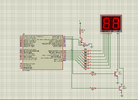thewiseishere
New Member
Hey guys i've been tryna build this 0-99 counter but i couldn't manage it. Can u help me out with it??

C:
#pragma config FOSC = INTIO67 // Oscillator Selection bits (Internal oscillator block)
#pragma config PLLCFG = OFF // 4X PLL Enable (Oscillator used directly)
#pragma config PRICLKEN = ON // Primary clock enable bit (Primary clock is always enabled)
#pragma config FCMEN = OFF // Fail-Safe Clock Monitor Enable bit (Fail-Safe Clock Monitor disabled)
#pragma config IESO = OFF // Internal/External Oscillator Switchover bit (Oscillator Switchover mode disabled)
// CONFIG2L
#pragma config PWRTEN = OFF // Power-up Timer Enable bit (Power up timer disabled)
#pragma config BOREN = OFF // Brown-out Reset Enable bits (Brown-out Reset disabled in hardware and software)
#pragma config BORV = 190 // Brown Out Reset Voltage bits (VBOR set to 1.90 V nominal)
// CONFIG2H
#pragma config WDTEN = OFF // Watchdog Timer Enable bits (Watch dog timer is always disabled. SWDTEN has no effect.)
#pragma config WDTPS = 32768 // Watchdog Timer Postscale Select bits (1:32768)
// CONFIG3H
#pragma config CCP2MX = PORTC1 // CCP2 MUX bit (CCP2 input/output is multiplexed with RC1)
#pragma config PBADEN = OFF // PORTB A/D Enable bit (PORTB<5:0> pins are configured as digital I/O on Reset)
#pragma config CCP3MX = PORTB5 // P3A/CCP3 Mux bit (P3A/CCP3 input/output is multiplexed with RB5)
#pragma config HFOFST = ON // HFINTOSC Fast Start-up (HFINTOSC output and ready status are not delayed by the oscillator stable status)
#pragma config T3CMX = PORTC0 // Timer3 Clock input mux bit (T3CKI is on RC0)
#pragma config P2BMX = PORTD2 // ECCP2 B output mux bit (P2B is on RD2)
#pragma config MCLRE = INTMCLR // MCLR Pin Enable bit (RE3 input pin enabled; MCLR disabled)
// CONFIG4L
#pragma config STVREN = ON // Stack Full/Underflow Reset Enable bit (Stack full/underflow will cause Reset)
#pragma config LVP = ON // Single-Supply ICSP Enable bit (Single-Supply ICSP enabled if MCLRE is also 1)
#pragma config XINST = OFF // Extended Instruction Set Enable bit (Instruction set extension and Indexed Addressing mode disabled (Legacy mode))
// CONFIG5L
#pragma config CP0 = OFF // Code Protection Block 0 (Block 0 (000800-003FFFh) not code-protected)
#pragma config CP1 = OFF // Code Protection Block 1 (Block 1 (004000-007FFFh) not code-protected)
#pragma config CP2 = OFF // Code Protection Block 2 (Block 2 (008000-00BFFFh) not code-protected)
#pragma config CP3 = OFF // Code Protection Block 3 (Block 3 (00C000-00FFFFh) not code-protected)
// CONFIG5H
#pragma config CPB = OFF // Boot Block Code Protection bit (Boot block (000000-0007FFh) not code-protected)
#pragma config CPD = OFF // Data EEPROM Code Protection bit (Data EEPROM not code-protected)
// CONFIG6L
#pragma config WRT0 = OFF // Write Protection Block 0 (Block 0 (000800-003FFFh) not write-protected)
#pragma config WRT1 = OFF // Write Protection Block 1 (Block 1 (004000-007FFFh) not write-protected)
#pragma config WRT2 = OFF // Write Protection Block 2 (Block 2 (008000-00BFFFh) not write-protected)
#pragma config WRT3 = OFF // Write Protection Block 3 (Block 3 (00C000-00FFFFh) not write-protected)
// CONFIG6H
#pragma config WRTC = OFF // Configuration Register Write Protection bit (Configuration registers (300000-3000FFh) not write-protected)
#pragma config WRTB = OFF // Boot Block Write Protection bit (Boot Block (000000-0007FFh) not write-protected)
#pragma config WRTD = OFF // Data EEPROM Write Protection bit (Data EEPROM not write-protected)
// CONFIG7L
#pragma config EBTR0 = OFF // Table Read Protection Block 0 (Block 0 (000800-003FFFh) not protected from table reads executed in other blocks)
#pragma config EBTR1 = OFF // Table Read Protection Block 1 (Block 1 (004000-007FFFh) not protected from table reads executed in other blocks)
#pragma config EBTR2 = OFF // Table Read Protection Block 2 (Block 2 (008000-00BFFFh) not protected from table reads executed in other blocks)
#pragma config EBTR3 = OFF // Table Read Protection Block 3 (Block 3 (00C000-00FFFFh) not protected from table reads executed in other blocks)
// CONFIG7H
#pragma config EBTRB = OFF // Boot Block Table Read Protection bit (Boot Block (000000-0007FFh) not protected from table reads executed in other blocks)
// #pragma config statements should precede project file includes.
// Use project enums instead of #define for ON and OFF.
const char cathode[10] ={0x3F, 0x06, 0x5B, 0x4F, 0x66, 0x6D, 0x7C, 0x07, 0x7F, 0x6F};
#define _XTAL_FREQ 8000000
#define display1 LATAbits.LATA0
#define display2 LATAbits.LATA1
#define button PORTAbits.RA2
#include <xc.h>
void main(void) {
char onesplace=0, tensplace=0, number=0;
TRISA = 0x04;
TRISB = 0x00;
ANSELB = 0x00;
ANSELA = 0x00;
PORTA = 0x00;
ANSELAbits.ANSA2=0;
display1 = 0;
display2 = 0;
while (1) {
onesplace = number % 10;
tensplace = number / 10;
display2 = 1;
display1 = 0;
PORTB = cathode[onesplace];
__delay_ms(5);
display2 = 0;
display1 = 1;
PORTB = cathode[tensplace];
__delay_ms(5);
display1 = 0;
// Check if the button is pressed
if (button == 1) {
__delay_ms(20); // Debounce delay
if (button == 1) {
number++;
while (button == 1)
{
display2 = 1;
PORTB = cathode[onesplace];
__delay_ms(5);
display2 = 0;
display1 = 1;
PORTB = cathode[tensplace];
__delay_ms(5);
display1 = 0;
}
}
}
// Reset the number if it exceeds 99
if (number > 99) {
number = 0;
}
}
}Attachments
Last edited by a moderator:

